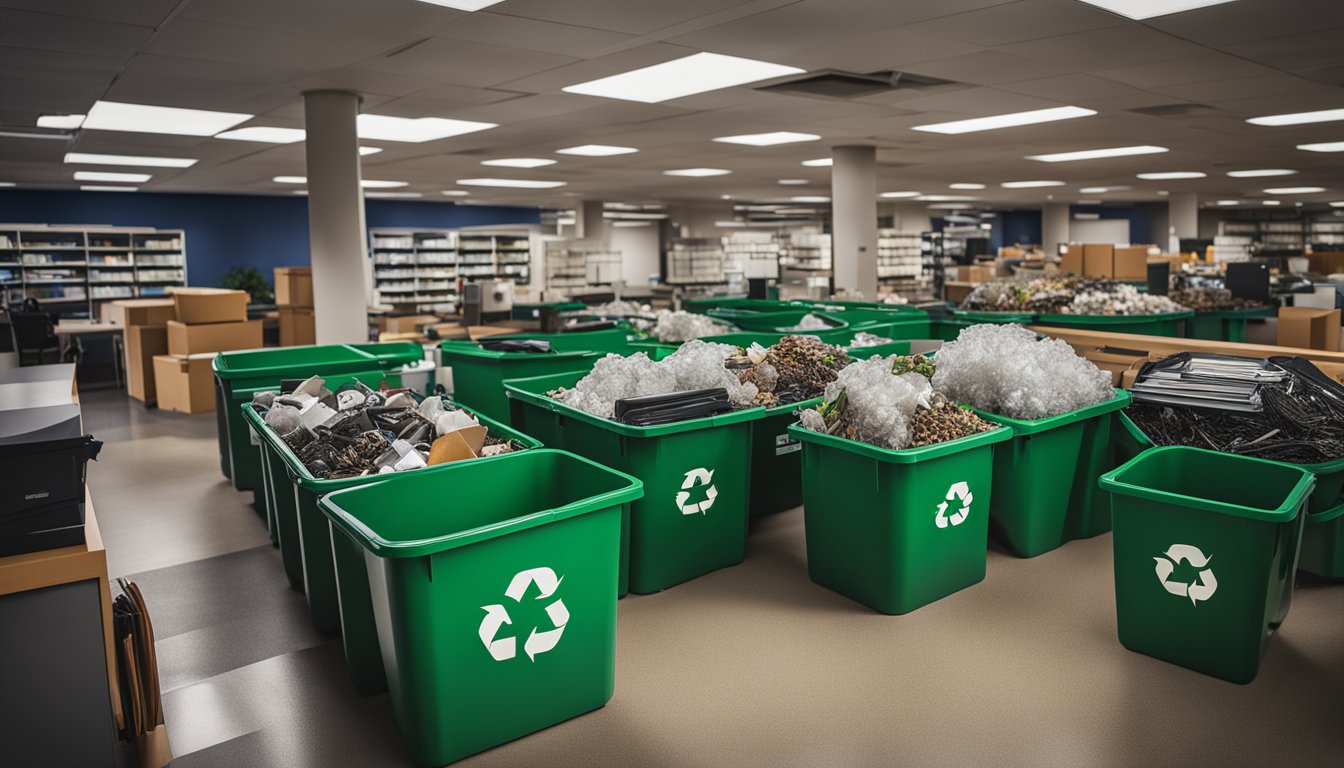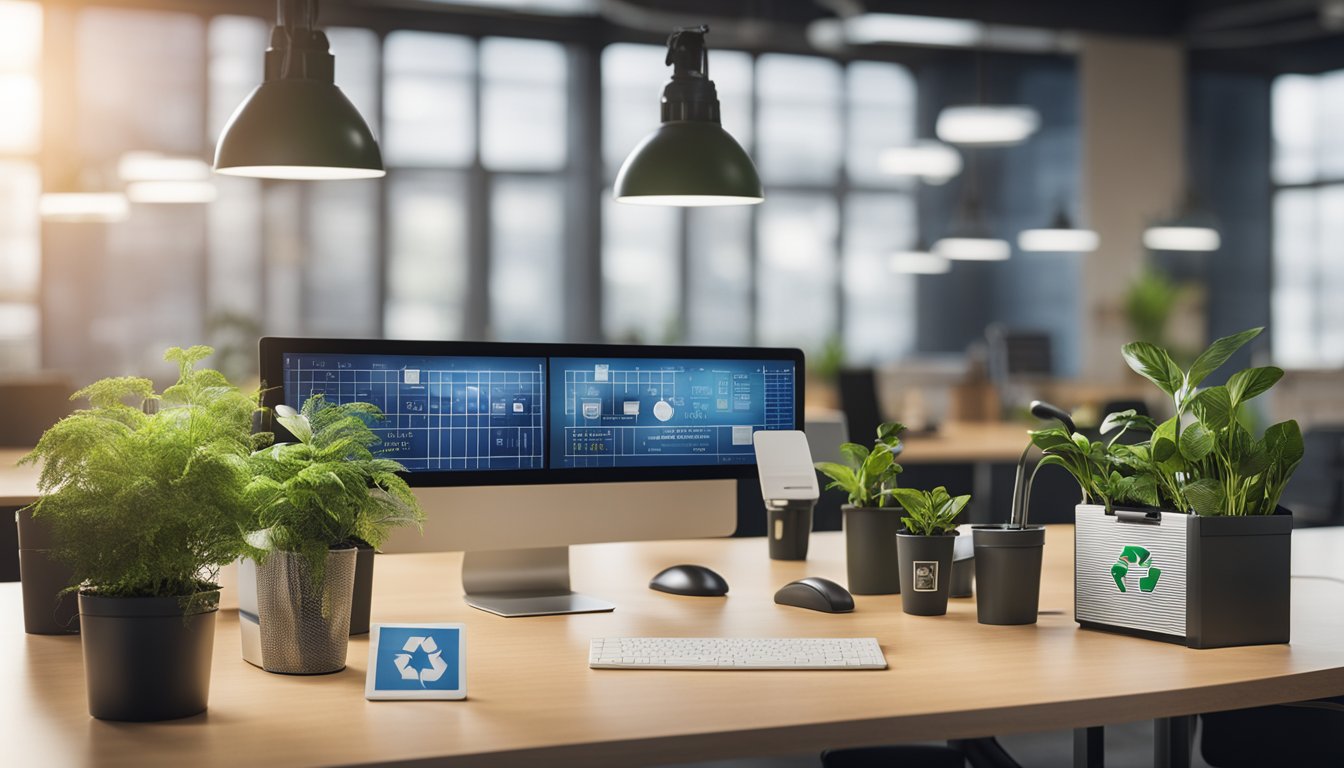Late updated: 15 Aug 2024 10:08
Written by: Amber Collins
Reducing Office Waste With Sustainable Practices: A Guide to Eco-Friendly Workspaces
Reducing office waste through sustainable practices doesn't just benefit the environment—it can also enhance productivity and cut costs. When we incorporate green practices into our daily routines, such as going digital and promoting recycling, we can significantly reduce the waste generated in our workplaces. These changes can be as straightforward as utilising energy-efficient LED light bulbs and encouraging employees to use cloud storage instead of paper documents.

Creating a zero-waste office requires a collective effort and a commitment to sustainability. Organisations can start by implementing comprehensive recycling initiatives for paper, plastic, glass, and electronics. Moreover, by purchasing coffee, tea, and other supplies in bulk, we can eliminate the need for wasteful individual packaging. Not only do these steps reduce waste, but they also foster a culture of environmental responsibility among employees.
Involving staff in sustainability initiatives can make the difference between success and failure. Offering recycling incentives and making sustainable practices engaging and fun can drive participation and enthusiasm. When employees feel involved and see the tangible impact of their actions, they're more likely to maintain and support these green initiatives.
Key Takeaways
- Implement digital practices to reduce paper waste
- Create comprehensive recycling programmes for various materials
- Engage employees with incentives and fun sustainability initiatives
Implementing Effective Waste Management Strategies
To address office waste with sustainable practices, we must focus on conducting waste audits, developing comprehensive recycling and composting programmes, promoting sustainable purchasing policies, and reducing single-use items and plastics.
Conducting a Waste Audit
Before implementing any waste management strategy, we need to understand the types and amounts of waste generated in the office. Conducting a waste audit involves:
- Collecting and categorising all waste over a set period.
- Identifying major waste contributors and potential areas for reduction.
- Using metrics to track improvements and document reductions.
By doing this, we can pinpoint inefficiencies and establish a baseline for future progress.
Developing Recycling and Composting Programmes
Establishing robust recycling and composting programmes is essential. For recycling, we should:
- Place clearly labelled recycling bins throughout the office.
- Educate employees on what can and cannot be recycled.
- Partner with reliable recycling services to ensure proper processing.
For composting:
- Set up compost bins in kitchen areas.
- Collect food scraps and organic waste.
- Work with a local composting facility or create an on-site composting system.
These programmes not only reduce landfill waste but also support our sustainability goals.
Promoting Sustainable Purchasing Policies
Sustainable procurement is a key element. Our focus should include:
- Selecting suppliers with strong environmental credentials.
- Prioritising purchases of recycled paper and eco-friendly office supplies.
- Adopting policies that favour products with minimal packaging.
We also need to communicate our sustainable purchasing policies clearly to all vendors and employees, ensuring everyone is aligned with our objectives.
Reducing Single-Use Items and Plastics
Single-use items and plastics contribute significantly to waste. Effective strategies include:
- Replacing disposable water bottles and utensils with reusable alternatives.
- Encouraging employees to use reusable cups, plates, and cutlery.
- Phasing out plastic packaging and opting for sustainable materials.
By promoting a culture of reuse, we can significantly decrease the volume of waste produced in our office.
Implementing these waste management strategies is crucial for creating a more sustainable, eco-friendly workplace. Through a combination of audits, comprehensive programmes, sustainable procurement, and reduction of single-use items, we can make a significant impact.
Enhancing Office Sustainability and Employee Engagement

By integrating environmentally conscious practices and actively involving employees, we can create a sustainable office environment that boosts productivity and reduces energy consumption. Specific strategies and initiatives help achieve these goals.
Incorporating Energy-Efficient and Renewable Energy Solutions
Energy consumption is a major concern in office settings. We can reduce energy use by installing energy-efficient appliances and lighting. Technologies such as LED lights and ENERGY STAR-certified equipment contribute significantly to energy conservation.
Adopting renewable energy sources, such as solar panels and wind turbines, further reduces our carbon footprint. Integrating these solutions not only helps in fighting climate change but also often results in cost savings over time.
Fostering a Culture of Sustainability
Building a sustainable office starts with creating a workplace culture that prioritises environmental responsibility. We can form a "green team" to lead sustainability initiatives and hold training sessions to educate employees.
Encouraging everyone to participate in sustainable office space practices helps embed these values into everyday operations. Simple actions like reusing materials, practising the "Three R's" (Reduce, Reuse, Recycle), and opting for sustainable furniture can make a big difference.
Encouraging Green Transportation and Remote Work
Green transportation offers significant benefits for reducing emissions. Promoting public transportation, carpooling, biking, and even walking can reduce our environmental impact.
Remote work is another effective measure. By allowing employees to work remotely, we can cut down on commuting emissions. Hybrid work models not only aid sustainability but also promote a better work-life balance, contributing to overall employee well-being.
Improving Resource Efficiency and Technological Adoption
Efficient use of resources involves streamlining our workflows and reducing waste. Implementing a paperless office approach can significantly cut down paper consumption. We can achieve this through the use of digital documents, electronic signatures, and online collaboration tools.
Adopting modern technology to optimise energy use is also crucial. Energy-efficient HVAC systems and smart meters help monitor and control energy usage more effectively. Additionally, resource management software can help track consumption and identify areas for improvement.
By following these strategies, we can enhance both our office sustainability and employee engagement, contributing to a healthier planet and a more productive workforce.
Frequently Asked Questions

In the context of reducing office waste and boosting sustainability, there are key aspects such as effective strategies, exemplary practices, waste management methods, contributions to green initiatives, and innovative measures that can lead to significant outcomes.
What are effective strategies for minimising waste in the workplace?
We can start by encouraging digital document use over paper, implementing recycling programmes, and educating employees about waste reduction. Additionally, adopting reusable supplies, like coffee mugs and cutlery, can significantly cut down on disposable waste.
Can you provide examples of environmental sustainability in office settings?
Incorporating energy-efficient lighting, using eco-friendly cleaning products, and setting up green plants to improve air quality are excellent examples. Moreover, sourcing office supplies from sustainable vendors and implementing policies to reduce printing are impactful measures.
What methods can businesses adopt to ensure effective office waste management?
We can set up clear recycling stations marked with appropriate categories for waste segregation. Composting organic waste is another method. Regular audits of waste production can also help in identifying areas for improvement.
How can offices contribute to the 'Go Green' initiative effectively?
We can embrace telecommuting options to reduce commuting emissions, promote carpooling or public transportation, and utilise energy-efficient appliances. Additionally, offices can invest in renewable energy sources, like solar panels, to lessen their carbon footprint.
What are some innovative green workplace initiatives that have a significant impact on sustainability?
Implementing a zero-waste policy, encouraging the upcycling of old office equipment, and organising workshops on sustainability can be quite impactful. Initiating green challenges within the office to foster a culture of environmental responsibility can also lead to substantial improvements.
In what ways can sustainability measures lead to a reduction in office waste disposal?
By adopting digital solutions, paper waste is greatly reduced. Energy-efficient practices lower overall consumption, reducing electronic waste. Furthermore, office-wide engagement in recycling programmes ensures fewer materials end up in landfills, contributing significantly to waste reduction.
